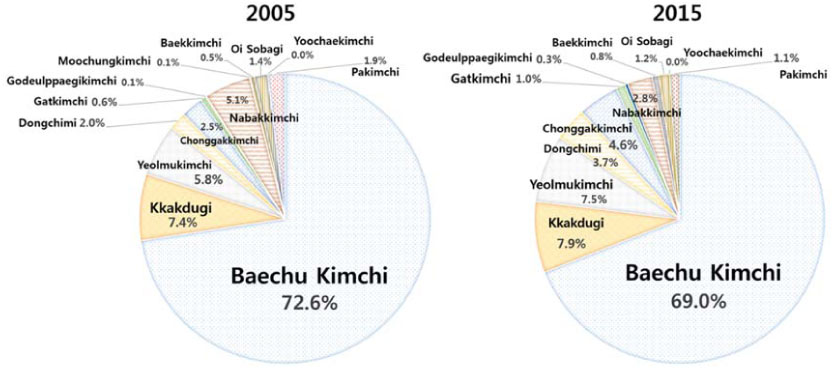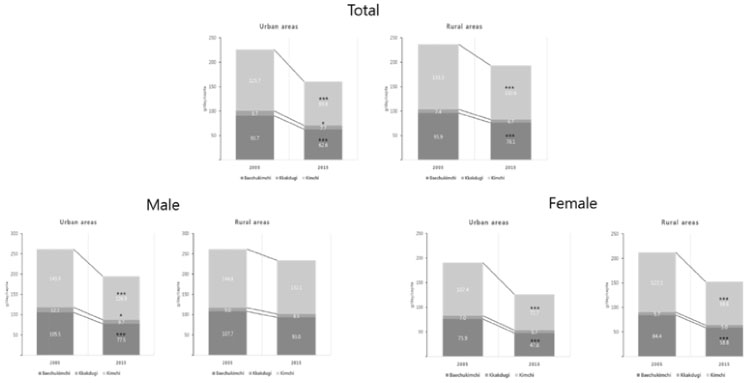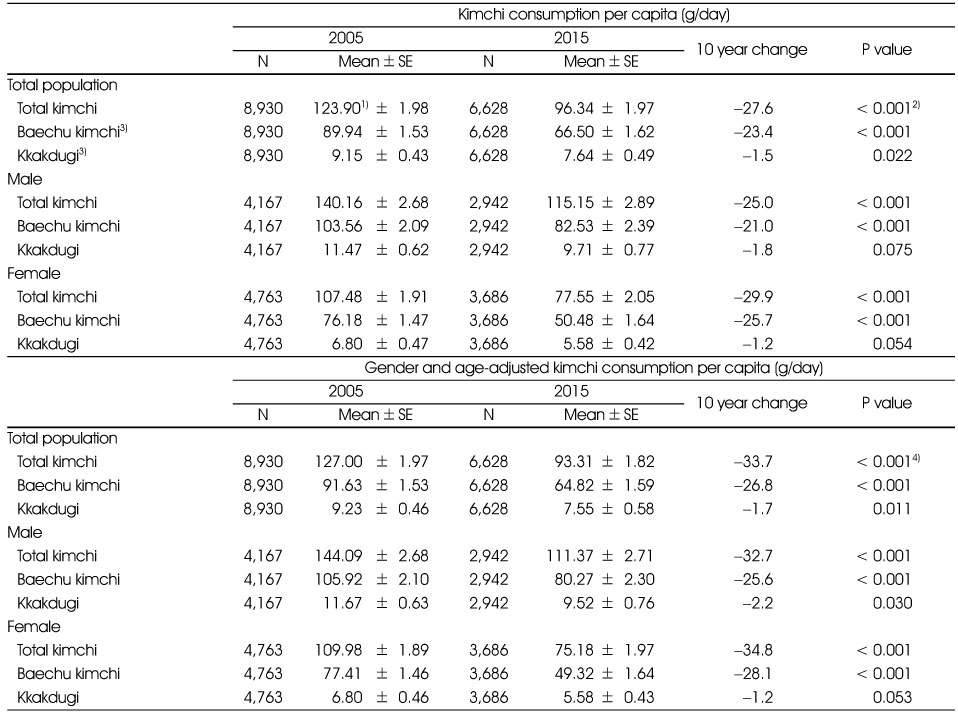Articles
- Page Path
- HOME > Korean J Community Nutr > Volume 22(2); 2017 > Article
-
Research Article
- Shifts in Kimchi Consumption between 2005 and 2015 by Region and Income Level in the Korean Population: Korea National Health and Nutrition Examination Survey (2005, 2015)
-
Junghyun Park, Hae-Jeung Lee

-
Korean Journal of Community Nutrition 2017;22(2):145-158.
DOI: https://doi.org/10.5720/kjcn.2017.22.2.145
Published online: April 30, 2017
1Institute for Aging and Clinical Nutrition Research, Gachon University, Seongnam-si, Gyeonggi-do, Korea.
2Department of Food and Nutrition, Gachon University, Seongnam-si, Gyeonggi-do, Korea.
- Corresponding author: Hae-Jeung Lee. 1342 Seongnamdaero, Sujeonggu, Seongnam-si, Gyeonggi-do, 13120, Korea. Tel: (031) 750-4720, Fax: (031) 750-5974, skysea1010@gmail.com
Copyright © 2017 The Korean Society of Community Nutrition
This is an Open-Access article distributed under the terms of the Creative Commons Attribution Non-Commercial License (http://creativecommons.org/licenses/by-nc/3.0/) which permits unrestricted non-commercial use, distribution, and reproduction in any medium, provided the original work is properly cited.
- 1,654 Views
- 12 Download
- 7 Crossref
Figure & Data
REFERENCES
Citations

- Effects of kimchi consumption on body fat and intestinal microbiota in overweight participants: A randomized, double-blind, placebo-controlled, single-center clinical trial
Wooje Lee, Min-Sung Kwon, Ye-Rang Yun, Hasun Choi, Mi-Ja Jung, Hyelyeon Hwang, Myung-Jun Shin, Jong-Hwan Park, Du-Ri Kim, Ji Yoon Chang, So Young Moon, Ho Jae Lee, Tae-Woon Kim, Tae Woong Whon, Sung Wook Hong
Journal of Functional Foods.2024; 121: 106401. CrossRef - Kimchi throughout millennia: a narrative review on the early and modern history of kimchi
Reggie Surya, David Nugroho
Journal of Ethnic Foods.2023;[Epub] CrossRef - Analysis of intake trends of kimchi, fruits and vegetables (1998–2020) and factors associated with the intake (2016–2020): based on the Korea National Health and Nutrition Examination Survey
Jiwon Jeong, Jungmin Park, Yu Kyung Lee, Sung Wook Hong, Sangah Shin
Journal of Nutrition and Health.2023; 56(4): 404. CrossRef - Exploring the philosophical values of kimchi and kimjang culture
Reggie Surya, Anne Ga-Yeon Lee
Journal of Ethnic Foods.2022;[Epub] CrossRef - Association of Korean fermented cabbage kimchi consumption with an incidence of metabolic syndrome: 10-year follow-up results of the Korean Genome and Epidemiology Study
Suk Hyeon Seo, Jiyoun Hong, Im Huei Son, Young Hee Han, Taisun Hyun
Journal of Nutrition and Health.2019; 52(6): 569. CrossRef - Comparison of the periodontal condition in Korean and Japanese adults: a cross-sectional study
Michiko Furuta, Kenji Takeuchi, Yoshihiro Shimazaki, Toru Takeshita, Yukie Shibata, Jun Hata, Daigo Yoshida, Deok-Young Park, Toshiharu Ninomiya, Yoshihisa Yamashita
BMJ Open.2018; 8(11): bmjopen-2018-024332. CrossRef - Inhibitory effects on N-nitrosodimethylamine formation by decrease of salted-fermented fish products and increase of condiments in kimchi
Sung Hyun Kim, Jeong Gyun Kim, Sanghyun Lee, Kyung Hun Kang, Sang-Hyun Kim, Soo-Jung Lee, Nak-Ju Sung, Mi Ja Chung
Food Science and Biotechnology.2017; 26(5): 1447. CrossRef
- Figure
- We recommend
- Related articles
-
- Analysis of the relationship between sugar intake and cancer prevalence: a cross-sectional study using the 8th Korea National Health and Nutrition Examination Survey
- Trends in growth and nutritional status of Korean toddlers and preschoolers: a cross-sectional study using 2010–2021 Korea National Health and Nutrition Examination Survey data
- Total sugar intake and its contributed foods by age groups in Koreans using the 8th (2019–2021) Korea National Health and Nutrition Examination Survey: a cross-sectional study
- Estimating and evaluating usual total fat and fatty acid intake in the Korean population using data from the 2019–2021 Korea National Health and Nutrition Examination Surveys: a cross-sectional study



Fig. 1
Fig. 2A
Fig. 2B
Distribution of socio-demographic factors in KNHANES 2005 and 2015
1) Korea National Health and Nutrition Examination Survey (KNHANES)
2) Chi-squared test was applied to compare the percent between 2005 and 2015.
3) Original number (weighted percent, %)
Changes of kimchi consumption in KNHANES 2005 and 2015 by gender
1) Mean daily per capita kimchi consumption
2) Student t-test was conducted to compare means per capita kimchi consumption between 2005 and 2015.
3) Baechu kimchi: napa cabbage kimchi, Kkakdugi: Korean radish kimchi
4) ANCOVA was performed and gender and age were adjusted.
Changes of kimchi consumption in KNHANES 2005 and 2015 by 16 cities and provinces of Korea
1) Mean daily per capita kimchi consumption
2) Student t-test was conducted to compare means per capita kimchi consumption between 2005 and 2015.
3) Baechu kimchi: napa cabbage kimchi, Kkakdugi: Korean radish kimchi
4) ANCOVA was performed and gender and age were adjusted.
Changes of kimchi consumption in KNHANES 2005 and 2015 by income level
1) Mean daily per capita kimchi consumption
2) Student t-test was conducted to compare means per capita kimchi consumption between 2005 and 2015.
Means in a column without a common letter are significantly different at α=0.05 by GLM/PDIFF
3) Baechu kimchi: napa cabbage kimchi, Kkakdugi: Korean radish kimchi
4) ANCOVA was performed and gender and age were adjusted.
1) Korea National Health and Nutrition Examination Survey (KNHANES) 2) Chi-squared test was applied to compare the percent between 2005 and 2015. 3) Original number (weighted percent, %)
1) Mean daily per capita kimchi consumption 2) Student t-test was conducted to compare means per capita kimchi consumption between 2005 and 2015. 3) Baechu kimchi: napa cabbage kimchi, Kkakdugi: Korean radish kimchi 4) ANCOVA was performed and gender and age were adjusted.
1) Mean daily per capita kimchi consumption 2) Student t-test was conducted to compare means per capita kimchi consumption between 2005 and 2015. 3) Baechu kimchi: napa cabbage kimchi, Kkakdugi: Korean radish kimchi 4) ANCOVA was performed and gender and age were adjusted.
1) Mean daily per capita kimchi consumption 2) Student t-test was conducted to compare means per capita kimchi consumption between 2005 and 2015. Means in a column without a common letter are significantly different at α=0.05 by GLM/PDIFF 3) Baechu kimchi: napa cabbage kimchi, Kkakdugi: Korean radish kimchi 4) ANCOVA was performed and gender and age were adjusted.

 KSCN
KSCN








 PubReader
PubReader Cite
Cite


